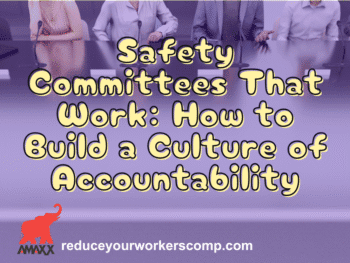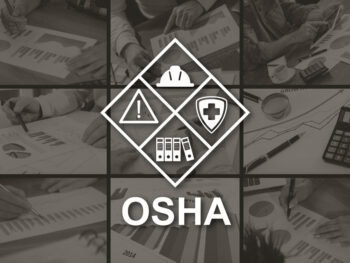Click Link to Access Free PDF Download
“4-Step Sequence For Effective Employee Screening, Hiring, & Placement”
Comparing ourselves to others personally, in terms of Facebook and Instagram can be a very dangerous activity, but in terms of business safety, workers’ compensation, key financial metrics is a very valuable exercise. Hello, my name is Michael Stack and I’m the CEO of Amaxx. And today I wanna talk about a metric, the total recordable incident rate, which is required to be tracked by OSHA, how to use that particular benchmark and metric to yourself, your organization, to your peers. Are you doing better or are you doing worse in terms of the number of incidents that you’re having? OSHA recordable incidents that you’re having compared to your peers? Are you doing good? Are you doing good? Are you doing bad? First? I wanna tell you what the total recordable ins rate is, how you track this, how you calculated it. It’s fairly simple. It’s the number of recordable incidents that you’re having.
So the number of recordable incidents and just a little cliff notes edition in terms of what is a recordable OSHA recordable incident, it’s days away, anything that has days away, anything that has days restricted. So anything that has days away or days restricted and anything medical beyond first aid beyond first aid and OSHA has a very specific definition of what is considered first aid. So if you’re like, well, is this first aid is a, that first aid. I’m not really sure it’s in the OSHA definition. If it’s not in the OSHA definition of what is considered first aid it’s, it’s beyond first aid. So in terms of workers compensation, anything days away, anything days restricted, anything medical beyond first aid. So if they’re going to see a physician, it’s, it’s an OSHA recordable incident and it’s a work comp claim, right? So that’s a little, uh, cliff notes edition there.
Number of incidents, times the number 200,000. So times the number 200,000 over your work hours. So the number of incidents you’re having times the number 200,000 and OSHA uses this number 200,000 to smooth out the base Mar baseline comparison. So this is equivalent to a 100 employees working fulltime. So it’s equivalent to 100 employees working full time. So if you’re a very large company, times it by 200,000, if you’re a very small company, eight times it by 200,000, that allows it to compare across sizes and industries. Number of incidents, time, 200,000 over a number of work hours. This comes directly out of your payrolls. That includes your part-time, your full-time employees. It doesn’t include vacation, pay, uh, sick pay, et cetera. That’s how you calculate this. What number do you come up with? Okay, you do this calculation. You figure this out, you look up, you look up this information and you figure out that you come out at 3.6.
Two is the number that you come up with. And you’re like, all right, great. 3.62. What does that mean? It’s dangerous to compare ourselves on Facebook and Instagram personally, cause like, oh, the Smith family. Oh, the Jones family. Oh, look at what they’re doing. They’re in The Bahamas. They’re in Florida. They’re vacationing in, in Hawaii. Oh, their life is so perfect. Blah, blah, blah. And we know that is not true. It’s a highlight reel and comparing ourselves. This is not good. It’s not good. Comparing ourselves though, with this key metric to the other metrics of your peers is very, very valuable to know how well you’re doing in terms of the number of incidents that you’re having. So I wrote these up here. These are directly out of OSHA street. You go to the bureau of labor statistics, website, table. Number one has all this information.
So 2.99 is the national average across all ind 2.9, zero national average across all industries, as far as the number of incident rates. So you’re at 3.62. All right. You’re a little bit above the national average, but let’s drill little bit deeper. 2.5 is construction. All right. So you’re that’s construction 3.1 is, uh, what is 3.1? This is, uh, this is transportation. This is agriculture. This is hospital 3.1 is transportation. 4.0 is agriculture. 7.6 is hospital. If you’re a hospital and you’re a 3.6, you’re under half of what the national average is. If you’re agriculture, you’re doing better. If you’re transportation, you’re a little bit higher. You could drill down by industry to understand how well you are doing in terms of incidents. It is an incredibly valuable exercise to know where you stand. Then you take this a little bit further, and now you’re tracking this by period for your owner organization.
You start with comparing to the national averages. Then you compare to yourself period, over period, as you’re working to improve and cut down on the number of incidents that are happening in your organization through improve safety training, through improve safety procedures, et cetera, et cetera, comparing ourselves personally is very dangerous. Comparing ourselves with safety metrics is extremely valuable. When you put this into practice, you will see those results because what gets measured can be improved. Again. My name is Michael Stack. I’m the CEO of Amaxx. Remember your work today. Worker’s compensation can have a dramatic impact on your company’s bottom line, but it will have a dramatic impact on someone’s life. So be great.
 Author Michael Stack, CEO Amaxx LLC. He is an expert in workers’ compensation cost containment systems and helps employers reduce their workers’ comp costs by 20% to 50%. He works as a consultant to large and mid-market clients, is a co-author of Your Ultimate Guide To Mastering Workers Comp Costs, a comprehensive step-by-step manual of cost containment strategies based on hands-on field experience, and is the founder & lead trainer of Amaxx Workers’ Comp Training Center, which offers the Certified Master of Workers’ Compensation national designation.
Author Michael Stack, CEO Amaxx LLC. He is an expert in workers’ compensation cost containment systems and helps employers reduce their workers’ comp costs by 20% to 50%. He works as a consultant to large and mid-market clients, is a co-author of Your Ultimate Guide To Mastering Workers Comp Costs, a comprehensive step-by-step manual of cost containment strategies based on hands-on field experience, and is the founder & lead trainer of Amaxx Workers’ Comp Training Center, which offers the Certified Master of Workers’ Compensation national designation.
Contact: mstack@reduceyourworkerscomp.com.
Workers’ Comp Roundup Blog: http://blog.reduceyourworkerscomp.com/
©2022 Amaxx LLC. All rights reserved under International Copyright Law.
Do not use this information without independent verification. All state laws vary. You should consult with your insurance broker, attorney, or qualified professional.
















